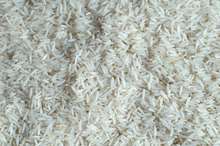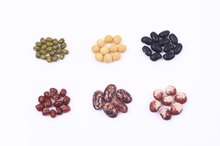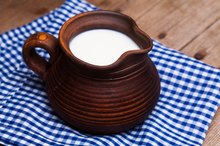What does fact checked mean?
At Healthfully, we strive to deliver objective content that is accurate and up-to-date. Our team periodically reviews articles in order to ensure content quality. The sources cited below consist of evidence from peer-reviewed journals, prominent medical organizations, academic associations, and government data.
- Diabetes/Metabolism Research and Reviews: Slow Versus Fast Proteins in the Stimulation of Beta-Cell Response and the Activation of the Entero-Insular Axis in Type 2 Diabetes
- Diabetes/Metabolism Research and Reviews: Slow Versus Fast Proteins in the Stimulation of Beta-Cell Response and the Activation of the Entero-Insular Axis in Type 2 Diabetes
- Metabolism: Clinical and Experimental: Combining Protein and Carbohydrate Increases Postprandial Insulin Levels but Does Not Improve Glucose Response in Patients With Type 2 Diabetes
- Metabolism: Clinical and Experimental: Combining Protein and Carbohydrate Increases Postprandial Insulin Levels but Does Not Improve Glucose Response in Patients With Type 2 Diabetes
The information contained on this site is for informational purposes only, and should not be used as a substitute for the advice of a professional health care provider. Please check with the appropriate physician regarding health questions and concerns. Although we strive to deliver accurate and up-to-date information, no guarantee to that effect is made.
Does Mixing Proteins With Carbs Reduce Insulin Response?
After eating a meal, the digestive system breaks foods down into nutrients that are absorbed into the bloodstream. Carbohydrates, broken down into sugars, cause an increase in blood sugar after meals. Rising blood sugar triggers secretion of the blood-sugar-lowering hormone insulin. This is called insulin response 3. Dietary proteins, broken down into amino acids, also stimulate the insulin response. However, the insulin response triggered by protein varies, depending on the food source. Additionally, the insulin response differs depending on whether the person has diabetes or not. While mixing protein with carbohydrate triggers an additive effect on insulin release, it is not clear whether this is helpful for people with diabetes.
Importance of Insulin Response
A rise in insulin after eating helps move sugar into body tissues, thereby keeping blood sugar from getting too high. However, excessive insulin secretion can have negative effects. Along with other factors, too much insulin may stress the pancreatic cells that secrete insulin. The exhausted cells can stop releasing insulin normally or die, which is detrimental because the body needs insulin to maintain normal blood sugar levels. Therefore, achieving a desirable level of insulin response that lowers blood sugar without exerting any adverse effects is essential.
- A rise in insulin after eating helps move sugar into body tissues, thereby keeping blood sugar from getting too high.
- The exhausted cells can stop releasing insulin normally or die, which is detrimental because the body needs insulin to maintain normal blood sugar levels.
Classifying Foods by Insulin Response
No Starch Diet Plan
Learn More
Foods have different effects on the insulin response, largely based on the relative concentration of carbohydrate, protein and, to a lesser extent, fat. The food insulin index (FII) classifies foods according to their after-meal insulin response. An August 2009 article published in the "American Journal of Clinical Nutrition" showed that refined cereals, sweets and potatoes have the highest FII, whereas nuts, beans and proteins have the lowest FII. This implies that, to keep insulin at desirable range, nuts, beans and proteins are better choices than refined cereals, sweets and potatoes. This is also consistent with diet recommendations for people with diabetes to limit the intake of carbohydrate, especially refined carbohydrate.
- Foods have different effects on the insulin response, largely based on the relative concentration of carbohydrate, protein and, to a lesser extent, fat.
- This is also consistent with diet recommendations for people with diabetes to limit the intake of carbohydrate, especially refined carbohydrate.
Protein Source and Insulin Response
The sources of protein are important in determining insulin response, as different proteins are digested and absorbed at different rates 2. For example, the major classes of milk proteins casein and whey have different absorption rates. Whey is absorbed much faster from the digestive tract than casein. A July 2007 article published in the "Diabetes/Metabolism Research and Reviews" showed that whey protein resulted in higher after-meal amino acid concentrations and a greater insulin response than casein 13. A July-August 2011 review in "Nutrición Hospitalaria" concluded that daily intake of at least one high-protein meal, especially whey protein, consumed with low to moderate amounts of carbohydrate increases insulin secretion and lowers blood sugar.
Mixing Protein With Carbohydrate
Foods a Borderline Diabetic Should Avoid
Learn More
Among healthy people, consuming protein with carbohydrate typically increases the insulin response and reduces blood sugar 3. However, this may not be the case for people with diabetes. A December 2012 article published in "Metabolism: Clinical and Experimental" found that in people with type 2 diabetes, combining protein with carbohydrate increased after-meal insulin levels, but it reduced insulin action and did not improve blood sugar 3. Reduced insulin action means that the ability of insulin to move sugar from the bloodstream to the body tissues is compromised, leading to elevated blood sugar.
Diet is an important factor in controlling blood sugar levels with T2DM. The American Diabetes Association does not recommend one specific diet for all people with diabetes but rather stresses the importance of an individualized approach. While protein is an important component of a healthy diet, it remains unclear whether the increased insulin response that typically occurs when mixing protein and carbs is beneficial for people with T2DM. Talk with your doctor and dietitian about the best way to incorporate a combination of protein and carbohydrates into your meal plans.
- Diet is an important factor in controlling blood sugar levels with T2DM.
- While protein is an important component of a healthy diet, it remains unclear whether the increased insulin response that typically occurs when mixing protein and carbs is beneficial for people with T2DM.
Related Articles
References
- Diabetes/Metabolism Research and Reviews: Slow Versus Fast Proteins in the Stimulation of Beta-Cell Response and the Activation of the Entero-Insular Axis in Type 2 Diabetes
- Nutrición Hospitalaria: Impact of Different Protein Sources in the Glycemic and Insulinemic Responses
- Metabolism: Clinical and Experimental: Combining Protein and Carbohydrate Increases Postprandial Insulin Levels but Does Not Improve Glucose Response in Patients With Type 2 Diabetes
- U.S. Centers for Disease Control and Prevention. Insulin resistance and diabetes. Last reviewed August 12, 2019.
- Wilcox G. Insulin and insulin resistance. Clin Biochem Rev. 2005;26(2):19–39.
- Ritchie RH, Zerenturk EJ, Prakoso D, Calkin AC. Lipid metabolism and its implications for type 1 diabetes-associated cardiomyopathy. J Mol Endocrinol. 2017 May;58(4):R225-R240. doi:10.1530/JME-16-0249
- Volpi, E. and Dickinson, J.M. (2015). Protein metabolism in health and diabetes. In International Textbook of Diabetes Mellitus (eds R.A. DeFronzo, E. Ferrannini, P. Zimmet and K.G.M.M. Alberti). doi:10.1002/9781118387658.ch16
- Colorado State University. Pathophysiology of the Endocrine System. Physiologic effects of insulin.
- University of Berkley, California. Endocrine Pancreas.
Resources
Writer Bio
Renee Thompson who received her bachelor of science from Purdue University in dietetics/nutrition, fitness, and health. She works as a registered dietitian for Community Hospitals providing diabetes education, weight loss education and other nutrition expertise.







